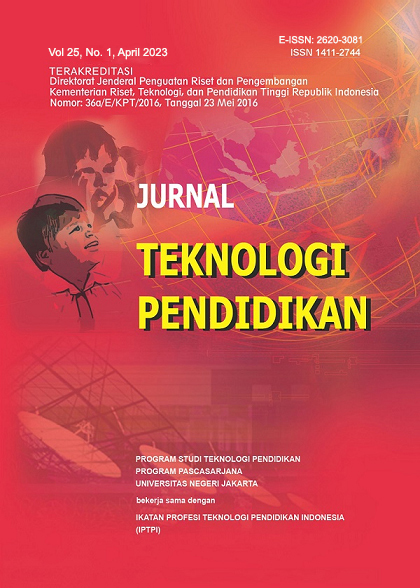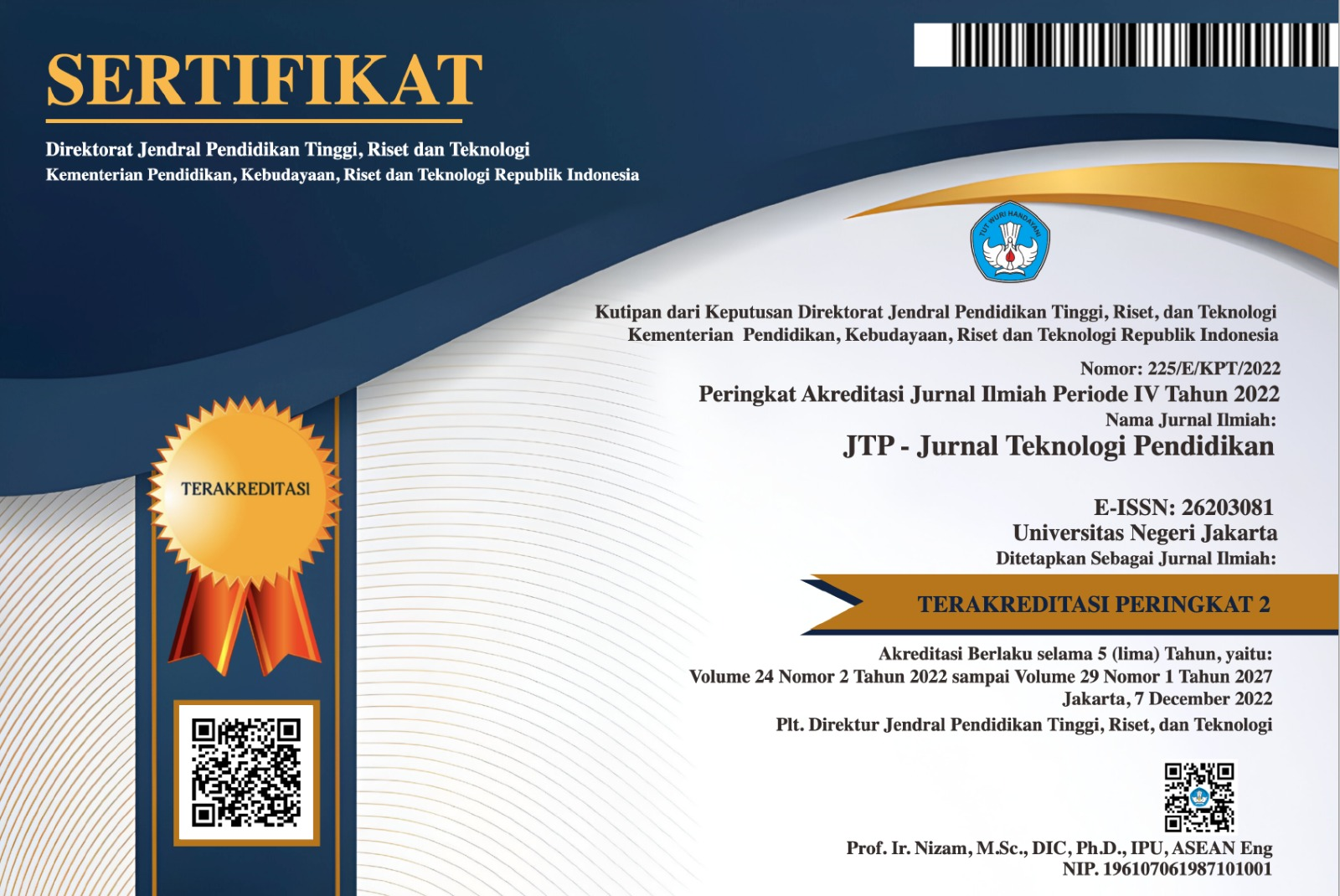The Use of Meaningful Learning in Distance Learning
Abstrak
This article aims to evaluate meaningful learning strategies in distance education. The application of meaningful learning is the emphasis of this class action research project with 32 respondents from class XI, in the application of meaningful Education using the principles of an advance organizer, progressive differentiation, integrative reconciliation, and consolidation in each learning activity. This study is classroom action research (CAR) conducted in two cycles. Data collection consisted of two research cycles: student activity data and student learning outcomes data. Student activity data was collected using observation sheets, while student achievement data was collected using the test method in each cycle. The criteria for grouping activities in each learning cycle use the ideal average and standard deviation. Sources of data include observations, questionnaires, and documentation for learning outcomes. The finding showed that meaningful learning model activities effectively increased student learning motivation. This can be seen from the increase in the average score of students on the test results; 67,15 in cycle 1 and 77,04 in cycle 2. The increase was also seen based on the results of the observations, which showed positive responses from students. From the results of the questionnaire, it is known that the average student perception score is 32.281 or 96%. This means that students positively respond to this learning model's application.
Referensi
(CSSE), the C. for S. S. and E. (2020). COVID-19 Dashboard. John Hopkins Coronavirus Resource Center. https://coronavirus.jhu.edu/map.html
Adarkwah, M. A. (2021). "I am not against online teaching, but what about us?": ICT in Ghana post Covid-19. Education and Information Technologies, 26(2), 1665–1685. https://doi.org/10.1007/S10639-020-10331-Z
Almaiah, M. A., Al-Khasawneh, A., & Althunibat, A. (2020). Exploring the critical challenges and factors influencing the E-learning system usage during the COVID-19 pandemic. Education and Information Technologies, 25(6), 5261–5280. https://doi.org/10.1007/S10639-020-10219-Y
Angelo, T. A., & Cross, K. P. (1993). Classroom Assessment Techniques: A Handbook for College Teachers (Jossey-Bass Higher and Adult Education Series). In Jossey-Bass Publishers (2nd ed., Vol. 46, Issue 12). http://www.amazon.com/Classroom-Assessment-Techniques-Jossey-Bass-Education/dp/1555425003
Ausubel. (1963). Cognitive Structure and the Facilitation of Meaningful Verbal Learning. Journal of Teacher Education, 14(2), 217–222. https://doi.org/10.1177/002248716301400220
Ausubel, D. (1968). Educational Psychology: A Motivation for the research question: A Cognitive View. Coloso University College.
Barrot, J. S. (2019). Facebook as a learning environment for language teaching and learning: A critical literature analysis from 2010 to 2017. Journal of Computer Assisted Learning, 34(6), 863–875. https://doi.org/10.1111/jcal.12295
Barrot, J. S. (2020). Scientific Mapping of Social Media in Education: A Decade of Exponential Growth. Journal of Educational Computing Research, 59(4), 645–668. https://doi.org/10.1177/0735633120972010
Barrot, J. S. (2021). Social media as a language learning environment: a systematic literature review (2008-2019). Computer-Assisted Language Learning. https://doi.org/10.1080/09588221.2021.1883673
Boelens, R., De Wever, B., & Voet, M. (2017). Four key challenges to the design of blended learning: A systematic literature review. Educational Research Review, 22, 1–18. https://doi.org/10.1016/J.EDUREV.2017.06.001
Carter, R. A., Rice, M., Yang, S., & Jackson, H. A. (2020). Self-regulated learning in online learning environments: strategies for remote learning. Information and Learning Science, 121(5–6), 311–319. https://doi.org/10.1108/ILS-04-2020-0114
Cavanaugh, C. S., Barbour, M. K., & Clark, T. (2009). Research and practice in K-12 online learning: A review of open access literature. International Review of Research in Open and Distance Learning, 10(1). https://doi.org/10.19173/IRRODL.V10I1.607
Copeland, W. E., McGinnis, E., Bai, Y., Adams, Z., Nardone, H., Devadanam, V., Rettew, J., & Hudziak, J. J. (2021). Impact of COVID-19 Pandemic on College Student Mental Health and Wellness. Journal of the American Academy of Child and Adolescent Psychiatry, 60(1), 134-141.e2. https://doi.org/10.1016/J.JAAC.2020.08.466
Day, T., Chang, I. C. C., Chung, C. K. L., Doolittle, W. E., Housel, J., & McDaniel, P. N. (2021). The Immediate Impact of COVID-19 on Postsecondary Teaching and Learning. Professional Geographer, 73(1), 1–13. https://doi.org/10.1080/00330124.2020.1823864
Donitsa-Schmidt, S., & Ramot, R. (2020). Opportunities and challenges: teacher education in Israel in the Covid-19 pandemic. Journal of Education for Teaching, 46(4), 586–595. https://doi.org/10.1080/02607476.2020.1799708
Elaish, M. M., Shuib, L., Ghani, N. A., & Yadegaridehkordi, E. (2019). Mobile English Language Learning (MELL): a literature review. Educational Review, 71(2), 257–276. https://doi.org/10.1080/00131911.2017.1382445
Fawaz, M., Al Nakhal, M., & Itani, M. (2022). COVID-19 quarantine stressors and management among Lebanese students: a qualitative study. Current Psychology, 41, 7628–7635. https://doi.org/10.1007/S12144-020-01307-W
Garcia, R., Falkner, K., & Vivian, R. (2018). Systematic literature review: Self-Regulated Learning strategies using e-learning tools for Computer Science. Computers and Education, 123, 150–163. https://doi.org/10.1016/J.COMPEDU.2018.05.006
Gonzalez, T., De La Rubia, M. A., Hincz, K. P., Comas-Lopez, M., Subirats, L., Fort, S., & Sachaid, G. M. (2020). Influence of COVID-19 confinement on students' performance in higher Education. PLoS ONE, 15(10), 1–23. https://doi.org/10.1371/journal.pone.0239490
Hakkarainen, P., Saarelainen, T., & Ruokamo, H. (2007). Towards meaningful learning through digital video-supported, case-based teaching. Australasian Journal of Educational Technology, 23(1), 87–109.
Hew, K. F., Jia, C., Gonda, D. E., & Bai, S. (2020). Transitioning to the “new normal” of learning in unpredictable times: pedagogical practices and learning performance in fully online flipped classrooms. International Journal of Educational Technology in Higher Education, 17(1), 1–22. https://doi.org/10.1186/S41239-020-00234-X
Huang, Q. (2019). Comparing teacher’s roles of F2f learning and online learning in a blended English course. Computer Assisted Language Learning, 32(3), 190–209. https://doi.org/10.1080/09588221.2018.1540434
Jonassen, D. H. (1995). Supporting Communities of Learners with Technology: A Vision for Integrating Technology with Learning in Schools. Educational Technology, 35(4), 60–63.
Jonassen, D. H., Howland, J., Moore, J., & Marra, R. M. (2003). Learning to Solve Problems with Technology: A Constructivist Perspective (2nd ed.). Merrill/Prentice Hall.
Jonassen, D. H., Peck, K. L., & Wilson, B. G. (1999). Learning with technology : a constructivist perspective (1st edition). Merrill Pub Co.
Jonassen, D. H., & Strobel, J. (2006). Modeling for meaningful learning. In Engaged Learning with Emerging Technologies (pp. 1–27). Springer Netherlands. https://doi.org/10.1007/1-4020-3669-8_1
Kapasia, N., Paul, P., Roy, A., Saha, J., Zaveri, A., Mallick, R., Barman, B., Das, P., & Chouhan, P. (2020). Impact of lockdown on learning status of undergraduate and postgraduate students during COVID-19 pandemic in West Bengal, India. Children and Youth Services Review, 116. https://doi.org/10.1016/J.CHILDYOUTH.2020.105194
Kebritchi, M., Lipschuetz, A., & Santiague, L. (2017). Issues and Challenges for Teaching Successful Online Courses in Higher Education. Journal of Educational Technology Systems, 46(1), 4–29. https://doi.org/10.1177/0047239516661713
Keengwe, J., Wachira, P., & Onchwari, G. (2008). The Use of Computer Tools to Support Meaningful Learning. https://www.researchgate.net/publication/255664048_The_Use_of_Computer_Tools_to_Support_Meaningful_Learning
Kemendikbud. (2013). Undang-Undang Republik Indonesia No. 20 Tahun 2013 Tentang Sistem Pendidikan Nasional.
Kemmis, S., McTaggart, R., & Nixon, R. (2014). The Action Research Planner. Springer Singapore.
Khalil, R., Mansour, A. E., Fadda, W. A., Almisnid, K., Aldamegh, M., Al-Nafeesah, A., Alkhalifah, A., & Al-Wutayd, O. (2020). The sudden transition to synchronized online learning during the COVID-19 pandemic in Saudi Arabia: A qualitative study exploring medical students’ perspectives. BMC Medical Education, 20(1), 1–10. https://doi.org/10.1186/S12909-020-02208-Z
Kunlasomboon, N., Wongwanich, S., & Suwanmonkha, S. (2015). Research and Development of Classroom Action Research Process to Enhance School Learning. Procedia - Social and Behavioral Sciences, 171, 1315–1324 | 10.1016/j.sbspro.2015.01.248. Procedia - Sosial and Behavioral Sciences, 171, 1315–1324. https://sci-hub.se/https://doi.org/10.1016/j.sbspro.2015.01.248
McKeachie, J., W., & Svinicki. (2014). McKeachie’s teaching tips: strategies, research, and theory for college and university teachers. Wadsworth, Cengage Learning.
Nicola, M., Alsafi, Z., Sohrabi, C., Kerwan, A., Al-Jabir, A., Iosifidis, C., Agha, M., & Agha, R. (2020). The socio-economic implications of the coronavirus pandemic (COVID-19): A review. International Journal of Surgery, 78, 185–193. https://doi.org/10.1016/J.IJSU.2020.04.018
Pham, T., & Nguyen, H. (2020). COVID-19: Challenges and opportunities for Vietnamese higher Education. Higher Education in Southeast Asia and Beyond, 8, 22–24. https://headfoundation.org/2020/06/09/covid-19-challenges-and-opportunities-for-vietnamese-higher-education/
Rasheed, R. A., Kamsin, A., & Abdullah, N. A. (2020). Challenges in the online component of blended learning: A systematic review. Computers & Education, p. 144, 103701. https://doi.org/10.1016/J.COMPEDU.2019.103701
Ruokamo, H., & Pohjolainen, S. (2000). Distance learning in a multimedia networks project: Main results. British Journal of Educational Technology, 31(2), 117–125. https://doi.org/10.1111/1467-8535.00142
Simbulan, N. P. (2020). COVID-19 and its impact on higher Education in the Philippines. Higher Education in Southeast Asia and Beyond, 8, 15–18. https://headfoundation.org/2020/06/04/covid-19-and-its-impact-on-higher-education-in-the-philippines/
Singh, K., Srivastav, S., Bhardwaj, A., Dixit, A., & Misra, S. (2020). Medical Education During the COVID-19 Pandemic: A Single Institution Experience. Indian Pediatrics, 57(7), 678–679. https://doi.org/10.1007/S13312-020-1899-2
Singh, V., & Thurman, A. (2019). How Many Ways Can We Define Online Learning? A Systematic Literature Review of Definitions of Online Learning (1988-2018). American Journal of Distance Education, 33(4), 289–306. https://doi.org/10.1080/08923647.2019.1663082
Sudira, P. (2006). Kurikulum Tingkat Satuan Pendidikan SMK. Departemen Pendidikan Nasional, Direktorat Jenderal Manajemen Pendidikan Dasar dan Menengah.
Suryaman, M., Cahyono, Y., Muliansyah, D., Bustani, O., Suryani, P., Fahlevi, M., Pramono, R., Purwanto, A., Purba, J. T., Munthe, A. P., Juliana, & Harimurti, S. M. (2020). COVID-19 pandemic and home online learning system: Does it affect the quality of pharmacy school learning? Systematic Reviews in Pharmacy, 11(8), 524–530. https://doi.org/10.31838/SRP.2020.8.74
Tallent-Runnels, M. K., Thomas, J. A., Lan, W. Y., Cooper, S., Ahern, T. C., Shaw, S. M., & Liu, X. (2006). Teaching courses online: A review of the research. Review of Educational Research, 76(1), 93–135. https://doi.org/10.3102/00346543076001093
Tang, T., Abuhmaid, A. M., Olaimat, M., Oudat, D. M., Aldhaeebi, M., & Bamanger, E. (2020). The efficiency of a flipped classroom with online-based teaching under COVID-19. Interactive Learning Environments. https://doi.org/10.1080/10494820.2020.1817761
Tanis, C. J. (2020). The seven principles of online learning: Feedback from faculty and alums on its importance for teaching and learning. Research in Learning Technology, p. 28. https://doi.org/10.25304/rlt.v28.2319
Theall, M., & Franklin, J. (2001). Looking for Bias in All the Wrong Places: A Search for Truth or a Witch Hunt in Student Ratings of Instruction? New Directions for Institutional Research, 2001(109), 45–56. https://doi.org/10.1002/IR.3
UNESCO. (2020). COVID-19 Educational Disruption and Response. UNESCO. https://en.unesco.org/news/covid-19-educational-disruption-and-response
Usher, M., & Barak, M. (2020). Team diversity as a predictor of innovation in team projects of face-to-face and online learners. Computers and Education, 144. https://doi.org/10.1016/J.COMPEDU.2019.103702
Varea, V., & González-Calvo, G. (2020). Touchless classes and absent bodies: teaching physical Education in times of Covid-19. Sport, Education and Society, 1–15. https://doi.org/10.1080/13573322.2020.1791814
Wallace, R. M. (2003). Online Learning in Higher Education: a review of research on interactions among teachers and students. Education, Communication & Information, 3(2), 241–280. https://doi.org/10.1080/14636310303143
Weimer, M. (1993). Improving Your Classroom Teaching. Survival Skills for Scholars. Volume 1. SAGE Publications, Inc., p. 2455 Teller Rd., Newbury Park, CA 91320 (hardcover: ISBN-0-8039-4975-8; paperback: ISBN-0-8039-4976-6, $11.95).
Yoni, A. (2010). Menyusun Penelitian Tindakan Kelas. Familia.
##submission.copyrightStatement##
##submission.license.cc.by-sa4.footer##Jurnal Teknologi Pendidikan is an Open Access Journal. The authors who publish the manuscript in Jurnal Teknologi Pendidikan agree to the following terms.
Attribution-ShareAlike 4.0 International (CC BY-SA 4.0)
-
Attribution — You must give appropriate credit, provide a link to the license, and indicate if changes were made. You may do so in any reasonable manner, but not in any way that suggests the licensor endorses you or your use.
-
ShareAlike — If you remix, transform, or build upon the material, you must distribute your contributions under the same license as the original.
- No additional restrictions — You may not apply legal terms or technological measures that legally restrict others from doing anything the license permits.
Notices:
- You do not have to comply with the license for elements of the material in the public domain or where your use is permitted by an applicable exception or limitation.
- No warranties are given. The license may not give you all of the permissions necessary for your intended use. For example, other rights such as publicity, privacy, or moral rights may limit how you use the material.








